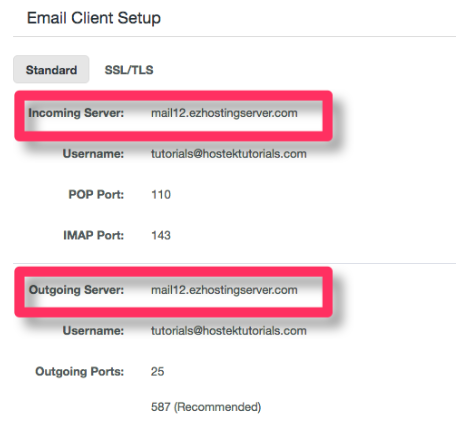E-Mail Configuration (Windows Environment)
Contents
E-Mail application settings info - Windows (SmarterMail)
In this tutorial we'll be showing how to find the correct Incoming / Outgoing settings to use for connecting to your e-mail account(s) on our Windows/SmarterMail environment. This information will be used to login to third-party e-mail applications such as Outlook, Thunderbird, Macmail, or maybe even your phone device for example.
Hostname
When connecting to your e-mail server you want to make sure you're making the connection to the right server that your e-mail is being hosted on, so let's go over your choices for what to put in the hostname field:
Important Note: Using this preconfigured address is required for the use of SSL on our shared SmarterMail servers.
The very first option that you can choose is the pre-configured hostname that we have setup on our shared & VPS servers. We'll show how you can obtain this information below:
This shared address uses a template format of either of the below where x is the mail server your site resides on. * x.ezhostingserver.com
Shared Example: If you're on Mail12 then the pre-configured address would be:
mail12.ezhostingserver.com
If you do not know the server you are on though you can either refer to your account information email, ask support, or you can obtain this hostname within your WCP control panel if you navigate to the following location:
Note: The above is just an example, however we have many shared mail servers so please check which server you are on instead of using the information in the above screenshot.
Custom hostname
Important Note: Using a custom hostname will not work for the use of SSL on our SHARED servers. You will need to use the preconfigured address mentioned in the above section.
The second option is most widely used as it allows the domain owner to use their own domain for the hostname in their email application.
Alright, so what is needed for you to be able to use something like mail.mydomain.com you ask? Well all that is needed is for the domain or subdomain that is being used as the hostname to point to the servers IP Address that is hosting the email for your domain.
Example:
For this example let's pretend we want to use mail.hostektutorials.com as the hostname and our e-mail is hosted on a server with an IP of 123.123.123.123
In this case we'd need to either create or update the record for 'mail.hostektutorials.com' to point to the IP Address 123.123.123.123. So when doing a DNS query for the domain you should see a result such as this screenshot below:
If you have your DNS pointing to our windows name servers then you can update this record through your cPanel by following the tutorial for Managing DNS Records via WCP. If your DNS is hosted elsewhere you'll need to contact that provider if you need help with creating this record.
Correct ports & settings to use
After knowing the correct hostname to use from the above section we now need to know what settings to use within our email application(s). When connecting to your email you can do so with either SSL or non-SSL.
Let's go ahead and show you the settings and ports to use within your e-mail application(s) for both SSL and non-SSL:
Standard (Non-SSL):
For incoming settings use the following for non-SSL:
Incoming Server: Covered in above section.
Incoming Type: - You can use either POP or IMAP on our shared servers.
(Note: IMAP by default leaves e-mails on the server when pulling e-mail to the application while POP by default downloads e-mails off the server - deleting from server - and saves them on the local application your connecting with.)
If using IMAP use port: 143
If using POP use port: 110
SSL: Turn SSL Off
Username: Use the full e-mail address your authenticating with such as example@hostektutorial.com.
Password: Use the correct password that is set for the e-mail address your authenticating as.
For outgoing settings use the following for non-SSL:
Outoing Server: Covered in above section.
SMTP Port: 25, 26, or 587 [Port 25 is commonly blocked by ISP (Internet Service Providers)]
SSL: Turn SSL Off
Username: Use the full e-mail address your authenticating with such as example@hostektutorial.com.
Password: Use the correct password that is set for the e-mail address your authenticating as.
Secure (SSL):
For incoming settings use the following for SSL:
Incoming Server: Covered in above section.
Incoming Type - You can use either POP or IMAP on our shared servers.
(Note: IMAP by default leaves e-mails on the server when pulling e-mail to the application while POP by default downloads e-mails off the server - deleting from server - and saves them on the local application your connecting with.)
If using IMAP use port: 993
If using POP use port: 995
SSL: Turn SSL ON
Username: Use the full e-mail address your authenticating with such as example@hostektutorial.com.
Password: Use the correct password that is set for the e-mail address your authenticating as.
For outgoing settings use the following for SSL:
Outoing Server: Covered in above section.
SMTP Port: 465
SSL: Turn SSL ON
Username: Use the full e-mail address your authenticating with such as example@hostektutorial.com.
Password: Use the correct password that is set for the e-mail address your authenticating as.

